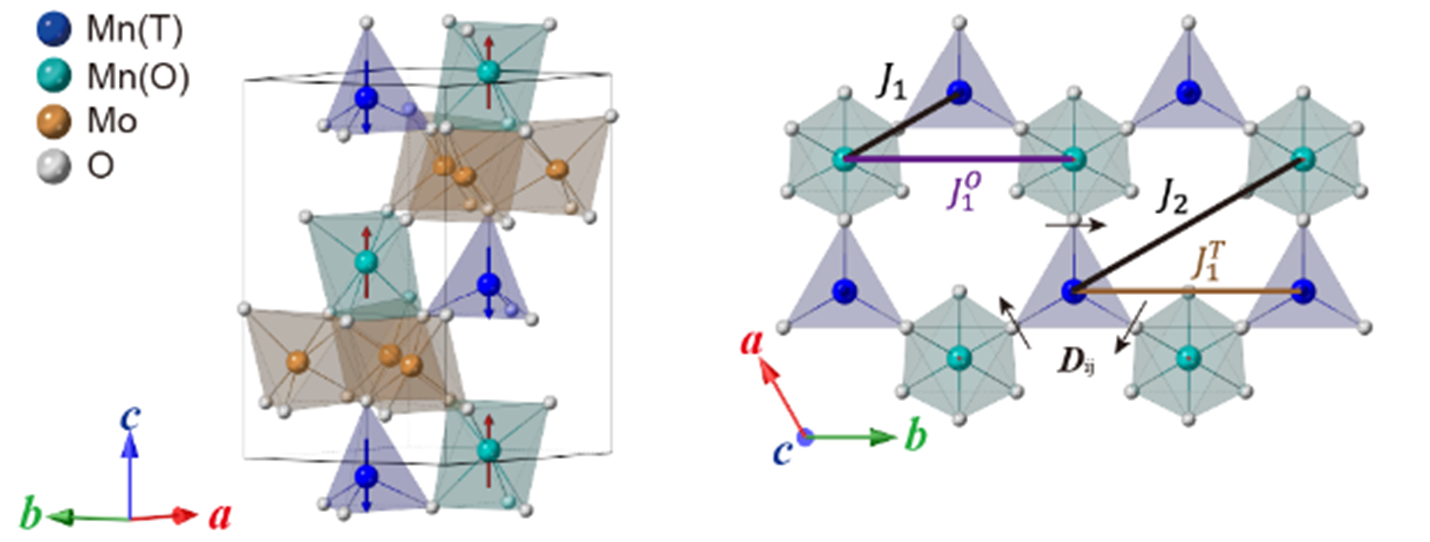The magnets A2Mo3O8 (where A can be Fe, Mn, Co or Ni) are well-known for their multiferroic properties. Multiferroics are technologically important materials which simultaneously exhibit electric order (alignment of electric dipoles in an electric field) and magnetic order (alignment of magnetic spins in a magnetic field). They have the potential for applications in memory storage, sensor technology and novel electronic devices.
The crystal structure of these A2Mo3O8 compounds consists of alternating Mo-O layers and A-O layers stacking along the c direction, as illustrated on the left-hand side of the image below. Within the A-O layer, the A2+ ions adopt two distinct oxygen coordination environments: AO6 octahedra and AO4 tetrahedra. These AO polyhedra collaboratively form a two-part honeycomb structure in the a-b plane, as depicted in the right-hand image below.

Below the magnetic ordering temperature, simultaneous breaking of time-reversal and space-inversion symmetry occurs, which results in nontrivial magnetoelectric effects. In addition, when the magnetic A2+ ions take this two-part structure, they create an intricate interplay that gives rise to abundant physical phenomena and excitation spectra seen across the A2Mo3O8 family.
A group of researchers from Nanjing University, collaborating with Devashibhai Adroja from ISIS, used inelastic neutron scattering on the Merlin instrument at ISIS along with theoretical modeling to investigate the unconventional L-type ferrimagnetism in Mn2Mo3O8, one of the compounds in this family of magnetic materials.
Inelastic neutron scattering is a powerful tool for understanding the energy of interactions between atoms and spins in a material. In this study, the researchers used their neutron experiments to investigate the degrees of freedom of the spins in the polar ferrimagnet and estimated various exchange parameters.
The magnetic excitation spectra they collected reveal two distinct magnon dispersions corresponding to the octahedral and tetrahedral spins in Mn2Mo3O8. These magnon bands can be well described by a spin Hamiltonian including Heisenberg and single-ion anisotropy terms. Using their theoretical model, they could successfully reproduce the unusual temperature dependence of the compound's L-type ferrimagnetic susceptibility.
They were also able to find out why this was the case - the different exchange pathways in the two sublattices of the structure result in different amplitudes of the exchange interactions, which leads to the L-type ferrimagnetism of Mn2Mo3O8. Their research provides valuable insights into the spin dynamics of L-type ferrimagnets.
Reference: J. Liao, Z. Huang, B. Zhang, Y. Shangguan, S. Cheng, H. Xu, Z. Song, S. Dong, D. Adrojia, S. Bao, and J. Wen, Physical Review B 111, 024407 (2025). DOI: 10.1103/PhysRevB.111.024407
